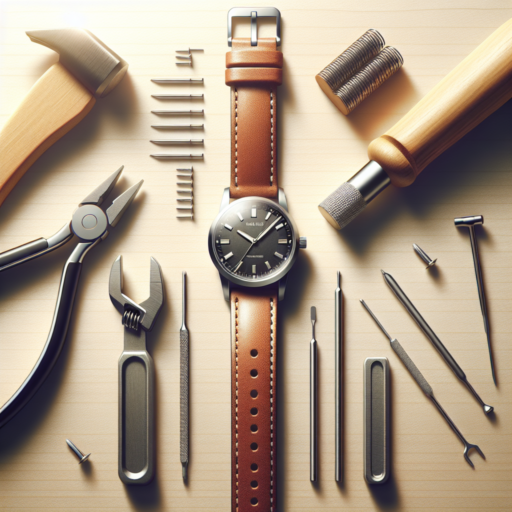How do I put the band on the watch?
Attaching a band to a watch may seem daunting at first, but with the right guidance, it can be a straightforward process. Whether you’re updating your old watch with a fresh strap or simply replacing a worn-out band, knowing how to secure it properly is crucial for both the look and comfort of your watch.
Firstly, identify the type of watch band you have, as the method can vary slightly. A typical watch band will have a small pin on each end that fits into designated holes on the watch case. If your watch has this system, you’ll need a tiny spring bar tool or a small flat-head screwdriver to remove or attach the band.
Start by positioning one end of the spring bar into the corresponding hole in the watch case. Then, using your tool, press down on the other end of the spring bar until you can slide it into the matching hole on the opposite side of the case. It might require a bit of pressure, so don’t be afraid to apply a gentle force. Ensure both ends of the spring bar are securely in place by giving the band a slight tug.
Remember, patience is key when attaching a watch band. If you’re struggling, take a break and revisit the instructions. With practice, swapping or replacing your watch band can become a quick and painless task.
Which way should a watch band go?
Determining which way a watch band should go can initially seem confusing, but it’s essential for both comfort and functionality. The orientation of a watch band can influence not only how the watch sits on your wrist but also how easily you can access its features. Generally, the buckle or clasp should be positioned on the side of the band that will be located on the underside of your wrist. This arrangement ensures that the longer portion of the band goes around the part of your wrist that’s wider, providing a more secure and comfortable fit.
For watches with additional features or complications, such as chronographs or smartwatches, ensuring that the band is correctly oriented makes accessing these features more intuitive. Buttons and touchscreens are easier to manipulate when the watch is securely and properly affixed to your wrist. Moreover, the correct orientation helps protect the watch’s clasp or buckle from unnecessary wear and tear, prolonging the life of the watch band.
It’s also worth noting that the traditional placement of a watch is on the left wrist for right-handed individuals and on the right wrist for those who are left-handed. This convention further affects how a watch band should be oriented for ease of use and comfort. Paying attention to the design of your watch band and how it fits with your watch can make a significant difference in your daily comfort and the functionality of your timepiece.
How to fasten a watch band?
Fastening a watch band is a simple procedure that can vary slightly depending on the type of watch band you have. Whether you’re dealing with a traditional buckle, a deployment clasp, or a modern smartwatch band, knowing the correct way to fasten your watch band will not only secure your watch comfortably on your wrist but also ensure its longevity. Below, we’ll guide you through the general steps for securing different types of watch bands.
Securing a Traditional Buckle Band
The traditional buckle band, reminiscent of a belt, is the most common type of watch band. To fasten it, slide the end of the band through the buckle, pulling it to your desired tightness. Then, secure the pin on the other end into one of the holes on the band. Make sure it’s snug yet comfortable. For added security, tuck the remaining part of the strap into the keeper loops. This method ensures that your watch stays securely on your wrist throughout the day.
Fastening a Deployment Clasp
Deployment clasps offer a sleek and secure way to wear your watch. To fasten a watch band with a deployment clasp, first unfold the clasp fully. Then, place the watch around your wrist and bring the two ends of the band together. Hook the latch onto the pin or bar located on the other end of the strap. Once hooked, fold the clasp back into its closed position. This type of clasp minimizes wear on the band and allows for effortless fastening and unfastening with its unique mechanism.
Understanding the specific type of watch band you have and following these simple steps will help you fasten your watch band correctly. While the process might seem straightforward, ensuring a secure and comfortable fit is crucial for the durability of the watch band and the safety of your watch.
No se han encontrado productos.
How do you set up a watch strap?
Setting up a watch strap might seem daunting at first, but with the right steps, it’s a straightforward process. Whether you’re looking to adjust a leather strap, resize a metal bracelet, or simply swap out a band to give your watch a new look, understanding the basics is key. Below, we’ll guide you through the essentials of setting up your watch strap for a perfect fit and impeccable style.
Finding the Right Tools
Before you start, ensure you have the right tools on hand. For metal straps, a small screwdriver or a watch pin removal tool is essential. Leather straps might require a simple spring bar tool. Having the right tools not only makes the process smoother but also prevents any damage to your watch strap or its mechanism.
Adjusting the Length of Your Watch Strap
- For metal bracelets: Locate the pins or screws on the bracelet links you wish to remove. Using your tool, carefully remove these to shorten the strap. To extend it, you may need additional links, which you can usually obtain from the manufacturer or a watch repair shop.
- For leather straps: Adjustment typically involves changing the buckle’s pin to a different hole on the strap. For straps with no holes or for a more precise fit, use a leather punch tool to create new holes as needed.
Securing the Strap
Once you’ve adjusted the strap to your liking, the final step is securing it in place. For metal straps, this means replacing the pins or screws you removed earlier. Make sure they’re fastened securely to avoid any potential loss. For leather straps and other materials, ensure the buckle is tightly secured and the strap ends are neatly tucked in. Properly securing your strap not only ensures the safety of your watch but also maintains its aesthetic appeal.




